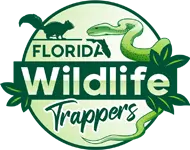Florida Cottonmouth
- Scientific Name
- Agkistrodon conanti
- Also Known As
- Green-tailed Moccasin
- Range
- All of Florida
- Diet
- Fish, Frogs, Turtles, Small Mammals
- Life Expectancy
- 15 - 20 Years
Quick Links
The Florida Cottonmouth in Central Florida
The Florida cottonmouth (Agkistrodon conanti) is a venomous pit viper subspecies found throughout central Florida. Often feared due to its defensive nature, cottonmouths play an important role in balancing local ecosystems.
This comprehensive guide provides identification tips, biology facts, behavior, ideal habitat conditions, diet, health risks, and prevention methods for cottonmouths in central Florida.
Appearance and Identification
The Florida Cottonmouth can be identified by the following characteristics
Key features distinguishing cottonmouths from nonvenomous water snakes include a broad, triangular head, vertical eye pupils, and the lack of longitudinal stripes on their stocky bodies.
Maturation Rate
Florida cottonmouths grow rapidly with ample food supply reaching adult size in 2 to 3 years after hatching. Lifespans in the wild average 8 to 10 years. Captive specimens can live over 20 years.
Habits and Behavior
Cottonmouths are semiaquatic snakes closely associated with waterways like cypress swamps, marshes, streams, and lakes. However, they may wander far from water in search of suitable habitat. When threatened, cottonmouths may stand their ground and open their mouth wide to expose the white interior, hence the name “cottonmouth.” If further provoked, they may suddenly strike and bite in defense. Cottonmouths prefer to escape if given the chance. Despite their reputation, cottonmouths are not aggressive unless disturbed.
In cold weather, cottonmouths brumate underground or in hollow logs and tree stumps. On warm winter days, they emerge to bask in the sun. Male cottonmouths engage in ritualized combat dancing during the breeding season. The snakes intertwine and attempt to push each other to the ground.
Reproduction and Lifespan
Cottonmouths breed in the spring after emerging from brumation. Females give birth to 4 to 12 live young about 3 to 5 months later in late summer. The newborns are fully independent from birth. They will reach between 15-20 years of age.
Ideal Habitat and Range
The warm, humid subtropical climate of central Florida provides ideal habitat for cottonmouths to flourish year-round. Average temperatures range from the 60s°F (15°C) in winter to over 90°F (32°C) in summer. Rainfall averages 50 to 60 inches annually, supporting dense wetland vegetation.
Abundant freshwater habitats like cypress swamps, marshes, lakes, streams, drainage canals and ditches dot the landscape. These permanent, slow-moving water sources allow cottonmouth populations to thrive. The snake’s cryptic coloration camouflages it against vegetation along the water’s edge where it waits to ambush prey.
Developed areas often provide suitable habitat if waterways or retention ponds are nearby. Cottonmouths may find refuge under debris in yards, parks, and gardens. Care should be taken in developed areas of central Florida given the region’s ideal wetland habitat and dense cottonmouth populations.
Diet and Feeding
Cottonmouths are opportunistic predators feeding mainly on fish, frogs, smaller snakes, turtles, small mammals, birds, crayfish and large insects. Hatchlings start on insects, frogs, lizards and small fish. Adults may consume prey up to 1/3 of their own body size.
Cottonmouths use venom to immobilize their prey before swallowing it whole. They locate prey using specialized infrared heat-sensing pits near their nostrils. These allow them to strike accurately even in dark water.
Cottonmouths often wait in ambush concealed near water’s edge or under vegetation. They may also actively pursue prey in shallows and along banks. Larger rodents, birds, snakes, and turtles are consumed by adult cottonmouths. Fish become a primary prey source for adults in regions where abundant.

Photo 117532866 © kgcowdery, CC BY-NC

Common Health Risks
While generally not aggressive, cottonmouths will bite in self-defense if threatened and their venom can be hazardous. Bites should receive rapid medical care to prevent serious injury and potential death in some cases.
Effects may include:
- Severe burning pain at the bite site
- Rapid swelling, bruising, bleeding
- Nausea, elevated heart rate
- Tissue damage, internal bleeding
- Loss of muscle coordination
- Vision problems from decreased blood flow
- Kidney failure from breakdown of muscle tissue (rhabdomyolysis)
Fatalities are rare from cottonmouth envenomation with only a 0.5-3% mortality rate when antivenom is administered. However, bites can result in permanent tissue damage and loss of digits. Seek emergency treatment immediately if bitten.
Preventing Cottonmouth Encounters
The likelihood of encountering cottonmouths can be reduced by taking preventive measures:
- Avoid reaching under brush, logs, and debris near waterways.
- Check before stepping over fallen logs crossing paths.
- Don’t swim or wade in vegetation-choked water.
- Keep hands and feet out of hollow stumps and logs.
- Wear snake gaiters and thick boots in wilderness areas.
- Carefully inspect yards and keep grass short.
- Seal foundations, vents, cracks in homes to exclude snakes.
- Remove snake-attracting habitat like wood piles and debris.
If you encounter a cottonmouth, give it plenty of space and allow it to retreat. Never attempt to kill or handle the snake. Signs like musky odor, shed skins, or droppings indicate recurrent snake activity at a site and the need for exclusion and habitat modification.
Florida Water Rats in Central Florida – Conclusion
Central Florida’s sub-tropical climate, abundant waterways and wetlands allow cottonmouth populations to thrive, especially in undeveloped areas. Caution is advised when near suitable cottonmouth habitat as encounters are possible.
Bites can have severe medical consequences, although deaths are infrequent with treatment. However, with vigilance, preventive measures, and avoiding harassment of the snakes, co-existence is entirely possible.
Cottonmouths are protected native species that play an important role in controlling rodent and reptile populations across central Florida’s complex wetland ecosystems.








